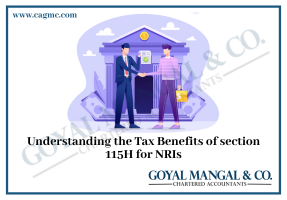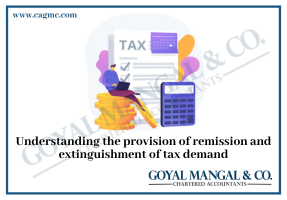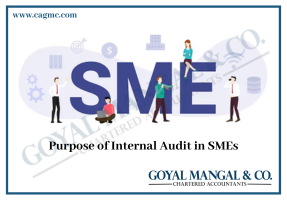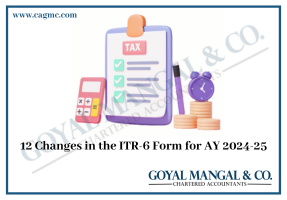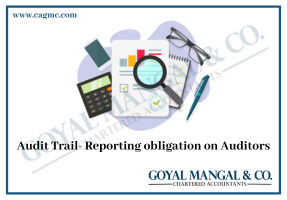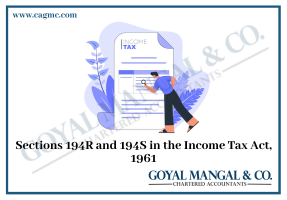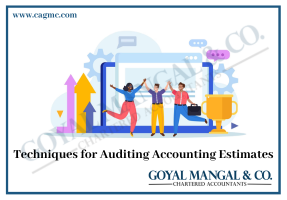
MAT stands for Minimum Alternate Tax. As the name suggest, it means minimum tax that any company needs to pay if other conditions are satisfied. Just like MAT has been introduced for companies, AMT (Alternate Minimum Tax) is brought for certain other entities. In this article we will discuss about MAT Credit Concepts and its Accounting. MAT provisions are covered under Section-115JB of the Income Tax Act. Before understanding the provisions of the law and understanding the accounting treatment, we need to see what is concept of MAT and why it was introduced in first place. So, let’s begin our journey.
|
Table of Contents |
What is MAT (Minimum Alternate Tax)?
MAT stands for Minimum Alternate Tax, is the minimum tax payable by a company. To understand this better let’s briefly see the background. The income of any company is calculated as per provisions of Companies Act. The income thus calculated is adjusted as per Income Tax Provisions, and companies claim deductions/exemptions on the income as per their eligibility. However, it was observed that even the companies with good amount of book profits ended up paying very low or even no tax. To bring such companies under the ambit of taxation MAT was introduced.
- Applicability of MAT – MAT is applicable on companies
- Non-Applicability of MAT – MAT is not applicable on following categories of companies.
- Companies who have opted for taxation at lower rates i.e., 22% u/s Sec.115BAA (companies foregoing certain special deduction and exemptions) or 15% u/s 115BAB (for new manufacturing companies). As to claim these lower rates companies have already foregone various deductions and exemptions under Income Tax Act.
- Where a company has income from life insurance business.
- Any shipping company, as their income is subject to tonnage taxation.
Rate of Tax under MAT
The company’s tax liability will be higher of the following:-
- Tax liability as per provisions of the Income Tax Act. I.e. tax on income calculated as per Income Tax rules and regulations.
- Tax @15% (plus surcharge and cess as applicable) on the book profits, computed as per provisions of Sec.115JB. This tax rate is called MAT.
Note:
- Rates of MAT have been changed from Finance Act 2020, from 18.5% to 15%.
- For companies that are unit of any International Financial Service Centre and those who derive their income only from convertible foreign exchange, the rate of MAT will be 9% (plus surcharge and cess).
What is MAT Credit?
As discussed earlier, company has to pay higher of the tax computed as per Income Tax Act or MAT provisions. This means, that whenever a company is paying tax as per MAT computation, the company has to pay more tax than its eligibility as per Income Tax Act.
The amount of tax excess paid is treated as MAT credit entitlement. The companies are allowed to carry forward MAT credit and claim its benefit in the subsequent years. MAT credit is treated as an asset in books of account. We will discuss accounting aspect in later part of this article.
Provisions for Adjustment and Carry Forward of MAT Credit
- MAT credit that is allowed to be carried forward is equal to (Tax As per MAT provisions- Tax as per normal provisions of Income Tax Act)
- MAT credit can be carried forward for a period of 15 Assessment Years.
- Tax credit can be utilized in the year when liability as per normal Income Tax provisions exceeds the liability as per MAT provisions.
- Set off will be allowed only to the extent of difference between the tax on its total income as per the normal provisions and as per MAT provisions.
- No interest is paid to the taxpayer in respect of such credit.
- Any company falling under the ambit of section 115JB should file a report from Chartered Accountant in Form-29B, certifying that profits have been computed as per provisions of Sec.115JB.
What is Book Profit for MAT calculation?
Calculation of book profits for calculation of MAT is a separate topic of discussion altogether. We will discuss it in brief here to understand the entire concept of MAT. To calculate Book Profits, most commonly, following additions/deletions are made to Profit/Loss calculated as per Schedule 3 of the Companies Act, 2013
Additions
- Provision for Income Tax Payable
- Provision for Unascertained liabilities, should not be added back if made on the basis of scientific approach.
- Paid/Proposed Dividends
- Any expense made to earn an income, which is exempt under Income Tax Act u/s 10 (Sec-10(38) excluded as LTCG for listed securities is now taxable at 10%),11,12
- Any amount carried to reserves ( except for reserves for a shipping company)
- Amount of depreciation debited in P&L Account
- Provision for diminution/reduction of any asset.
- Deferred Tax and any provision made for the same.
- If the value available in revaluation reserve, for an asset that has been disposed/sold during the current year, is not credit to P&L Account than such amount should be added back to book profits.
- Expenditure relatable to income by way of royalty in respect of patent
- The amount of expenditure in relation to share of income of an individual form an AOP/BOI which is not taxable under Income Tax Act.
- Capital gain from security transactions
- Interest, royalty or fees for technical services.
- If a Foreign Company incurs any expenditure in relation to income arising from
Deletions
- Any amount withdrawn from any reserve, if credited to P&L Account
- Incomes which are exempt u/s 10,11,12 of Income Tax Act.
- Amount of depreciation debited to P&L ( the amount of depreciation on revaluation of assets should not be taken)
- Amount of brought forward losses or unabsorbed depreciation, whichever is lower.
- Deferred Tax if credited to the Profit and Loss Account.
- If a Foreign Company earns any income arising from
- Capital gain from security transactions
- Interest, royalty or fees for technical services.
- Income by way of royalty in respect of patent
Accounting Treatment of MAT Credit
We have discussed, that MAT credit is treated as an asset in books of accounts and also seen that same can be carried forward and set-off against tax liability. Now, we will see that how all these things are recorded in books of accounts.
Let us take an example of a Company say XYZ Ltd.
Year1
The company is having a liability of Rs. 15,000/- as per normal provisions of Income Tax Act and Rs.20,000/- as per provisions for MAT.
Now, the company is liable to pay Rs.5000/- more due to MAT Provisions.
So, the company will record an asset in Books of Accounts for Rs.5000/-
- MAT Credit A/c Dr. 5000
To MAT Credit(P&L) A/c Cr. 5000
Also the company needs to record a liability of tax payable at Rs.20,000/-
- Tax Expense(P&L) A/c Dr. 20000
To Provision for Tax A/c Cr. 20000
The presentation in Statement of Profit and Loss Account will be as follows:-
| Particulars | Amount |
| Total Revenue | XXXX |
| Total Expenses | (XXXX) |
| Profit Before Tax | XXX |
| Tax Expenses:- | |
| Current Tax Expenses | 20000 |
| MAT credit entitlement | (5000) |
| Total Tax Expenses | 15000 |
| Net profit after Tax | XXX |
The presentation in Balance Sheet will be as follows:-
| Particulars | Amount |
| Non-current Liabilities*
Deferred Tax Liabilities (Net) |
|
| MAT Credit Entitlement | (5000) |
| Current Liabilities
Short Term Provisions |
|
| Provision for Tax | 20000 |
Year2
Now in Year-2, tax will be paid for Year-1 while filing the return. The journal entry at that time would be-
Payment of Tax
- Provision for Tax A/c Dr. 20000
To Bank A/c 20000
At this point, the balance in Provision for Tax is nil, and MAT credit stands at Rs.5000/-. At the end of Year-2, the tax calculations will be done again. Say this year, the liability as per normal income tax provisions is Rs.18,000/- and as per MAT provisions is Rs.15,000/-.
Now the accounting will be done as follows:-
Availing MAT credit and creating balance liability
- Tax Expense(P&L) A/c Dr. 15000
MAT Cr. utilized(P&L)A/c Dr. 3000
To MAT credit A/c Cr. 3000
To Provision for Tax A/c Cr. 15000
The presentation in Statement of Profit and Loss Account will be as follows: –
| Particulars | Amount(Rs.) |
| Total Revenue | XXXX |
| Total Expenses | (XXXX) |
| Profit Before Tax | XXX |
| Tax Expenses:- | |
| Current Tax Expenses | 15000 |
| MAT credit entitlementutilized | 3000 |
| Total Tax Expenses | 18000 |
| Net profit after Tax | XXX |
The presentation in Balance Sheet will be as follows: –
| Particulars | Amount |
| Non-current Liabilities*
Deferred Tax Liabilities (Net) |
|
| MAT Credit Entitlement | (2000) |
| Current Liabilities
Short Term Provisions |
|
| Provision for Tax | 15000 |
(*)Presentation of MAT credit in balance sheet under deferred tax liabilities is in line recent accounting standards, as definition of deferred tax includes any “unutilized tax credit”. However, a guidance note issued by ICAI in 2006 in this regard suggests otherwise and recommends showing it under Non-Current Assets as Loans and Advances. As both Balance Sheet Format and Accounting Standard have changed a great deal since the guidance note presentation as discussed above is preferred.
Conclusion
Above is the basic discussion about Basic Concepts and Accounting of MAT Credit. MAT is a provision which was introduced by government to collect tax from “zero tax paying companies”. With introduction of new sections as discussed above, certain companies have gone out of the ambit of MAT applicability. Key points to be kept in mind while accounting are that MAT credit is to be treated as an asset and credit can be utilized only to the extent of difference between Tax as per Income Tax provisions and Tax as per MAT provisions. We hope this article, will help you in understanding the Concepts of MAT credit and its accounting treatment.
